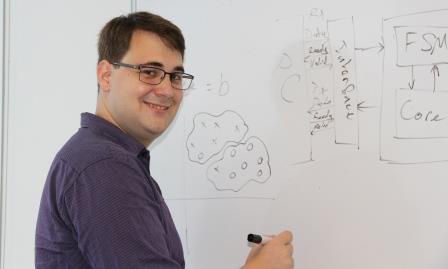Algorithm designer on the cusp of data centre transformation

Algorithms designed by a University of Sydney student researcher could help reduce the electricity consumption of power-hungry data centres and cloud facilities, as well as deliver information faster.
Amid growing concerns surrounding the potential environmental impacts of massive data centres, Duncan Moss, a PhD candidate in the School of Electrical and Information Engineering, has been invited to undertake a 12-month research internship with global technology company Intel.
Moss will be based at Intel’s Data Center Cloud Platform Group in Hillsboro, USA.
“Data centres are avid consumers of power and, if allowed to continue to expand in their current form, could become a major consumer of the world’s energy supply,” said Moss. He will join Intel’s team in investigating better methods for using new chips to be released in 2017, which combine CPUs (central processing units) and FPGAs (field-programmable gate arrays).
Moss said FPGAs are specialty chips used to speed up certain kinds of computer workloads, such as machine learning.
“The FPGA chip has also been around for a while, but is difficult to work with; however, Intel’s new technology will make it mainstream,” he said.
“It’s like being given two buckets of Lego blocks. The CPU bucket only has one type of Lego block, so it can only be made into one thing, but the FPGA bucket has all kinds of blocks — small, large, rectangle or square — an assortment that can be changed into any desired configuration.
“We can change the FPGA part to suit our needs, but the CPU can’t be altered. Also, FPGAs are far more energy efficient than CPUs on a performance-per-watt basis.”
Moss, who was 14 when he built his first computer from off-the-shelve components, said the collaboration with Intel will be an “amazing opportunity” for him.
“The particular FPGA algorithm that I will be able to develop will allow data centres to run with less power but just as efficiently.”
Professor Philip Leong, Moss’s PhD supervisor, added: “Greenpeace noted that if the cloud were a country, it would have the fifth largest electricity demand in the world. Duncan’s work is extremely timely as it will utilise Intel’s technology to dramatically improve the speed and power consumption of these data centres.”
How digital twins are changing the way data centres are designed
Digital twins have the potential to rewrite the design rules for data centres.
Future-proofing business operations in Fiji
Fijian conglomerate Motibhai Group has modernised its IT operations with a hyperconverged...
Should AI actually be the biggest IT sustainability concern?
The broader IT sustainability conversation is disproportionately focused on AI, even as other...



